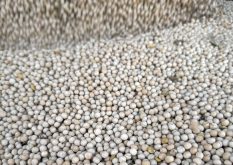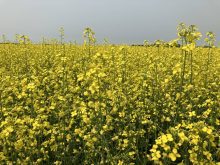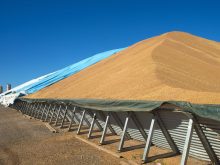Canadian canola meal shipments to China have exploded.
Crushers shipped 656,660 tonnes of the product worth $218 million to China in 2016, up from nothing the previous year.
It sounds like a new market for the product, but really it is just a market that has resurfaced after a three-year hiatus.
“The main reason why it has increased is because Canada was blocked on shipping anything there for a couple of years,” said Glen Pownall, managing director of Peter Cremer Canada.
Meal exports were restricted in 2013 when China implemented new registration requirements for Canadian processors shipping meal to that market.
Read Also

Russian wheat exports start to pick up the pace
Russia has had a slow start for its 2025-26 wheat export program, but the pace is starting to pick up and that is a bearish factor for prices.
Most of the key crushers have now met the registration requirements, although some companies and facilities have not.
Export volumes are just now returning to pre-registration levels. For instance, crushers shipped 585,986 tonnes of meal to China in 2011 and 824,554 tonnes the year before that.
The United States is still by far the biggest market for Canadian canola meal, accounting for 82 percent of exports in 2016.
However, it is nice for crushers to once again have another outlet for the product with China taking 15 percent of exports. The meal is primarily used by the country’s aquaculture sector but also works its way into dairy and hog rations.
Pownall said the reduction in Chinese rapeseed production because of the removal of price subsidies is another reason for the strong demand.
The U.S. Department of Agriculture is forecasting 13.5 million tonnes of Chinese rapeseed production in 2016, a 10 percent reduction from the previous year.
Those numbers are based on Chinese government estimates, but Pownall said they aren’t correct.
“Their domestic crop has dropped dramatically and is significantly below what the Chinese government says it is,” he said.
Pownall estimates production at four to five million tonnes, which means feed manufacturers need to import meal to replace what is no longer being produced at Chinese rapeseed crush facilities.
Canada could ship more to that market because the demand is there, but there are logistical issues.
“We’re pumping out so much seed into China now it’s occupying logistical capacity on the West Coast,” he said.
The Canola Council of Canada continues to do market development work in China to differentiate Canadian canola meal from competing products.
The main message is that canola meal has very low levels of glucosinolates. They give feed a bitter taste, and livestock production drops if the levels are too high.
The council has done feeding trials with the dairy industry, and that is paying dividends.
“The dairy companies are starting to really see that Canadian canola meal is a really good product,” said Brittany Dyck, canola meal manager with the council.
The council is currently conducting hog research trials with New Hope, a large Chinese feed company that also owns hogs.
“We are working to demonstrate to them that they can use inclusion levels of canola meal at a much higher level than they would currently be comfortable using.”
The trials are using 20 percent canola meal in feed rations for grower-finisher diets instead of the five percent that would typically be used.
Research shows that hog operations can incorporate up to 20 percent canola meal in pig diets and get the same performance as 100 percent soybean meal diets.
















